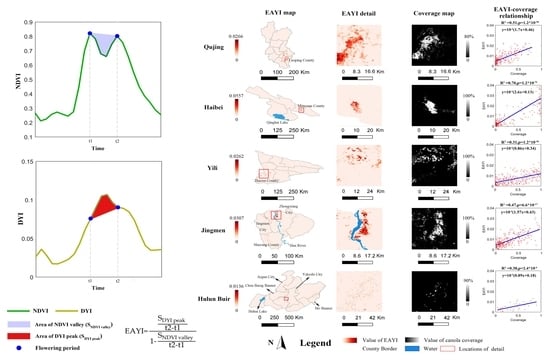Remote Sensing Index for Mapping Canola Flowers Using MODIS Data
Abstract
:1. Introduction
2. Materials and Methods
2.1. Study Areas
2.2. Dataset and Preprocessing
2.2.1. Data
2.2.2. Preprocessing of MODIS Time Series
2.3. Temporal Characteristics of Canola Spectra
2.4. Development of the EAYI for Canola Flowering Mapping
2.4.1. Determination of the Flowering Period
2.4.2. EAYI Index for Canola Flowering Mapping
2.5. Mapping and Evaluation of the EAYI
3. Results
3.1. EAYI Map Derived from MODIS Data
3.2. Comparison with Canola Coverage Interpreted from High-Resolution Imagery
3.3. Comparison with Census Yield Data
4. Discussion
4.1. Superiorities of the EAYI
4.2. Remaining Challenges and Future Researches
5. Conclusions
Supplementary Materials
Author Contributions
Funding
Conflicts of Interest
References
- Zhang, X.; He, Y. Rapid estimation of seed yield using hyperspectral images of oilseed rape leaves. Ind. Crop. Prod. 2013, 42, 416–420. [Google Scholar] [CrossRef]
- Li, L. Research on Farmers’ Landscape Rape Planting Behavior in Huhai Tourism Destination; Jiangxi Agricultural University: Nanchang, China, 2016. [Google Scholar]
- Yin, Y.; Wang, H. Current situation and Development Trend of Rapeseed production in China. Agric. Outlook 2011, 7, 43–45. [Google Scholar]
- Liu, C.; Feng, Z.; Xiao, T. Development status, potential and countermeasures of Rape industry in China. Chin. J. Oil Crop. 2019, 41, 485. [Google Scholar]
- Ashourloo, D.; Shahrabi, H.S.; Azadbakht, M.; Aghighi, H.; Nematollahi, H.; Alimohammadi, A.; Matkan, A.A. Automatic canola mapping using time series of sentinel 2 images. Isprs J. Photogramm. Remote Sens. 2019, 156, 63–76. [Google Scholar] [CrossRef]
- Sulik, J.J.; Long, D.S. Spectral indices for yellow canola flowers. Int. J. Remote Sens. 2015, 36, 2751–2765. [Google Scholar] [CrossRef]
- Sulik, J.J.; Long, D.S. Spectral considerations for modeling yield of canola. Remote Sens. Environ. 2016, 184, 161–174. [Google Scholar] [CrossRef] [Green Version]
- Fang, S.; Tang, W.; Peng, Y.; Gong, Y.; Dai, C.; Chai, R.; Liu, K. Remote estimation of vegetation fraction and flower fraction in oilseed rape with unmanned aerial vehicle data. Remote Sens. 2016, 8, 416. [Google Scholar] [CrossRef] [Green Version]
- Shen, M.; Chen, J.; Zhu, X.; Tang, Y. Yellow flowers can decrease NDVI and EVI values: Evidence from a field experiment in an alpine meadow. Can. J. Remote Sens. 2009, 35, 99–106. [Google Scholar] [CrossRef]
- Shen, M.; Chen, J.; Zhu, X.; Tang, Y.; Chen, X. Do flowers affect biomass estimate accuracy from NDVI and EVI? Int. J. Remote Sens. 2010, 31, 2139–2149. [Google Scholar] [CrossRef]
- Tao, J.; Wu, W.; Liu, W.; Xu, M. Exploring the Spatio-Temporal Dynamics of Winter Rape on the Middle Reaches of Yangtze River Valley Using Time-Series MODIS Data. Sustainability 2020, 12, 466. [Google Scholar] [CrossRef] [Green Version]
- d’Andrimont, R.; Taymans, M.; Lemoine, G.; Ceglar, A.; Yordanov, M.; van der Velde, M. Detecting flowering phenology in oil seed rape parcels with Sentinel-1 and-2 time series. Remote Sens. Environ. 2020, 239, 111660. [Google Scholar] [CrossRef] [PubMed]
- Tao, J.; Wu, W.; Xu, M. Using the Bayesian Network to map large-scale cropping intensity by fusing multi-source data. Remote Sens. 2019, 11, 168. [Google Scholar] [CrossRef] [Green Version]
- Mercier, A.; Betbeder, J.; Baudry, J.; Le Roux, V.; Spicher, F.; Lacoux, J.; Roger, D.; Hubert-Moy, L. Evaluation of Sentinel-1 & 2 time series for predicting wheat and rapeseed phenological stages. ISPRS J. Photogramm. Remote Sens. 2020, 163, 231–256. [Google Scholar]
- Lei, Y. Development status and Countermeasures of rape industrialization in Luoping County. Yunnan Agric. Sci. Technol. 2003, 6, 1–2. [Google Scholar]
- Chen, J.; Jönsson, P.; Tamura, M.; Gu, Z.; Matsushita, B.; Eklundh, L. A simple method for reconstructing a high-quality NDVI time-series data set based on the Savitzky–Golay filter. Remote Sens. Environ. 2004, 91, 332–344. [Google Scholar] [CrossRef]
- Fang, S. Separation of trend yield and climate yield. Chin. J. Nat. Disasters 2011, 20, 13. [Google Scholar]
- Wadleigh, C.H.; Shaw, R.H.; Thompson, L.M.; Dale, R.F.; Auer, L.; Durost, D.D.; Hurst, R.L.; Willett, H.C.; Bean, L.H.; Palmer, W.C.; et al. Weather and Our Food Supply; Center for Agricultural and Economic Development, Iowa State University: Ames, IA, USA, 1964; pp. 9–22. [Google Scholar]
- Zhang, J.; Zhao, Y.; Ding, Z. Research on the relationships between rainfall and meteorological yield in irrigation district. Water Resour. Manag. 2014, 28, 1689–1702. [Google Scholar] [CrossRef]
- Hodrick, R.J.; Prescott, E.C. Postwar US business cycles: An empirical investigation. J. Money Credit Bank 1997, 1–16. [Google Scholar] [CrossRef]
- Wang, G.Z.; Lu, J.S.; Chen, K.Y.; Wu, X.H. Exploration of method in separating climatic output based on HP filter. Chin. J. Agrometeorol. 2014, 35, 195–199. [Google Scholar]
- Li, J.; Liu, C.; Wang, H.; Zhang, J. Study on extraction Method of Planting area of Rapeseed from Luoping based on multi-source remote sensing data. J. Southwest. Univ. (Nat. Sci.) 2008, 38, 33–138. [Google Scholar]
- He, Y.; Min, X.; Jiang, G.; Jian, X.; Gao, Q.; She, S. On the Characteristics and Enlightenment of rapeseed flower Tourism Development around Qinghai Lake under eye Effect. Hunan Agric. Sci. 2016, 11, 76–78. [Google Scholar]
- Cui, H.; Yao, Q.; Chen, J.; Lin, X. Current situation and development ideas of spring rapeseed production in Zhaosu region. Anhui Agric. Sci. Bull. 2016, 22, 38–40. [Google Scholar]
- Lian, B.; Guo, J.; Jiao, Y. Discussion on the current situation, Problems and Countermeasures of rape industry development in Hulun Buir city. Inn. Mong. Agric. Sci. Technol. 2010, 3, 76–77. [Google Scholar]
- Chen, X.; Wang, W.; Chen, J.; Zhu, X.; Shen, M.; Gan, L.; Cao, X. Does any phenological event defined by remote sensing deserve particular attention? An examination of spring phenology of winter wheat in Northern China. Ecol. Indic. 2020, 116, 106456. [Google Scholar] [CrossRef]
- Piao, S.; Liu, Q.; Chen, A.; Janssens, I.A.; Fu, Y.; Dai, J.; Liu, L.; Lian, X.; Shen, M.; Zhu, X. Plant phenology and global climate change: Current progresses and challenges. Glob. Chang. Biol. 2019, 25, 1922–1940. [Google Scholar] [CrossRef] [PubMed]
- Guo, L.; An, N.; Wang, K. Reconciling the discrepancy in ground-and satellite-observed trends in the spring phenology of winter wheat in China from 1993 to 2008. J. Geophys. Res. Atmos. 2016, 121, 1027–1042. [Google Scholar] [CrossRef] [Green Version]
- Dong, Q.; Chen, X.; Chen, J.; Zhang, C.; Liu, L.; Cao, X.; Zang, Y.; Zhu, X.; Cui, X. Mapping Winter Wheat in North China Using Sentinel 2A/B Data: A Method Based on Phenology-Time Weighted Dynamic Time Warping. Remote Sens. 2020, 12, 1274. [Google Scholar] [CrossRef] [Green Version]
- Kaufman, Y.J.; Remer, L.A. Detection of forests using mid-nir reflectance—An application for aerosol studies. IEEE Trans. Geosci. Remote Sens. 1994, 32, 672–683. [Google Scholar] [CrossRef]
- Zhu, X.; Chen, J.; Gao, F.; Chen, X.; Masek, J.G. An enhanced spatial and temporal adaptive reflectance fusion model for complex heterogeneous regions. Remote Sens. Environ. 2010, 114, 2610–2623. [Google Scholar] [CrossRef]
- Zhu, X.; Cai, F.; Tian, J.; Williams, T.K. Spatiotemporal fusion of multisource remote sensing data: Literature survey, taxonomy, principles, applications, and future directions. Remote Sens. 2018, 10, 527. [Google Scholar]
- Schmitt, M.; Tupin, F.; Zhu, X.X. Fusion of SAR and optical remote sensing data—Challenges and recent trends. In Proceedings of the 2017 IEEE International Geoscience and Remote Sensing Symposium (IGARSS), Fort Worth, TX, USA, 23–28 July 2017; pp. 5458–5461. [Google Scholar]

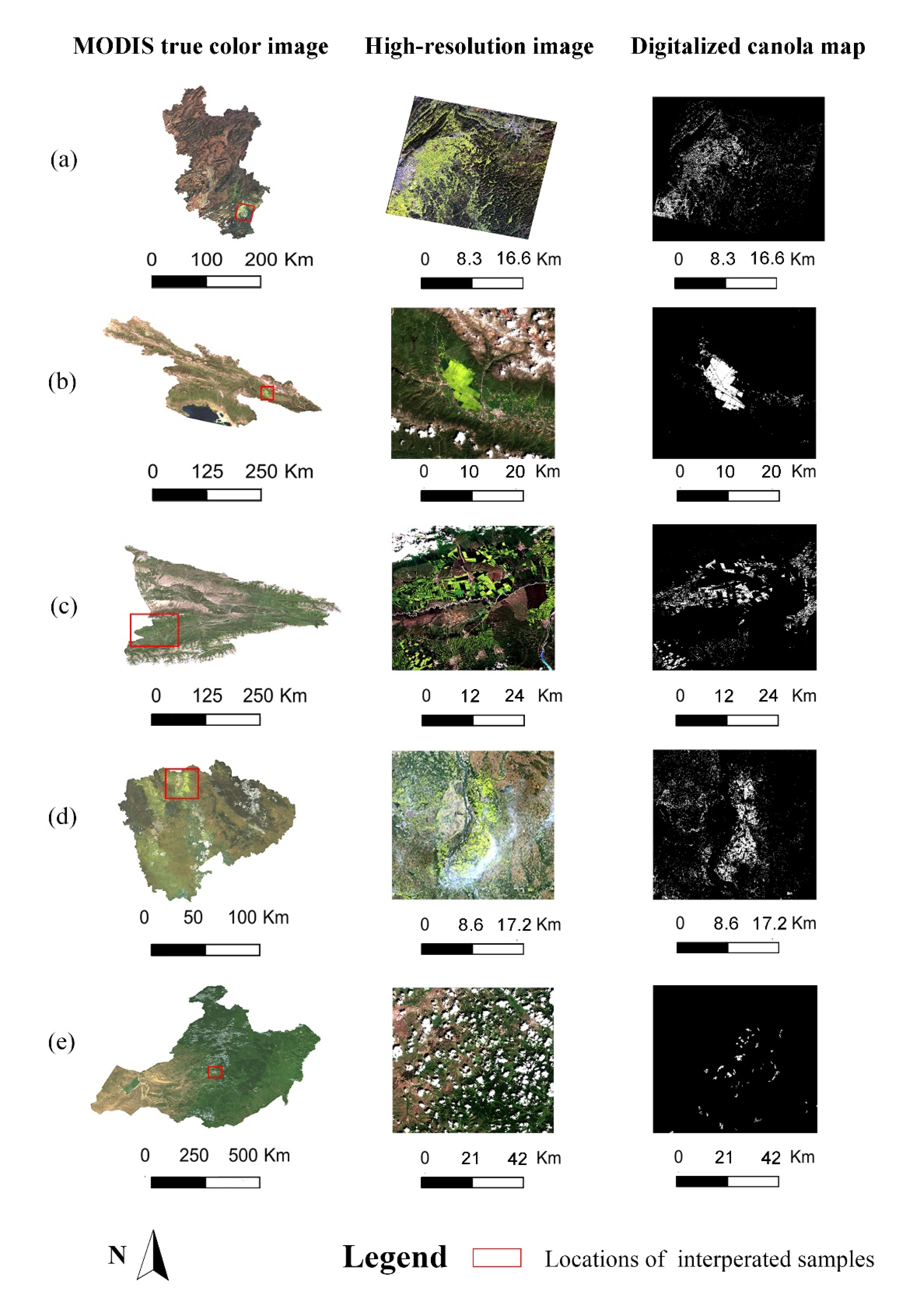
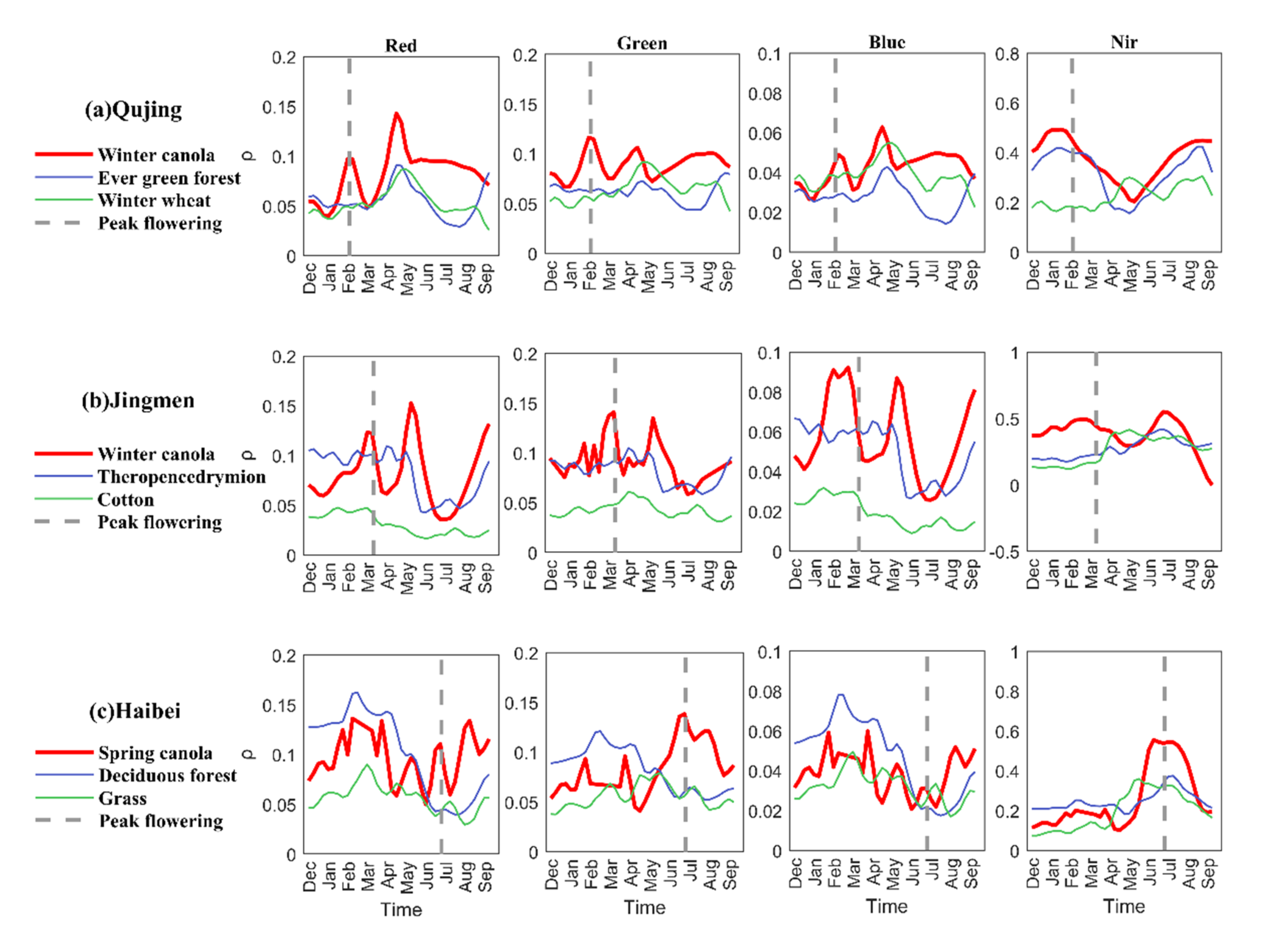
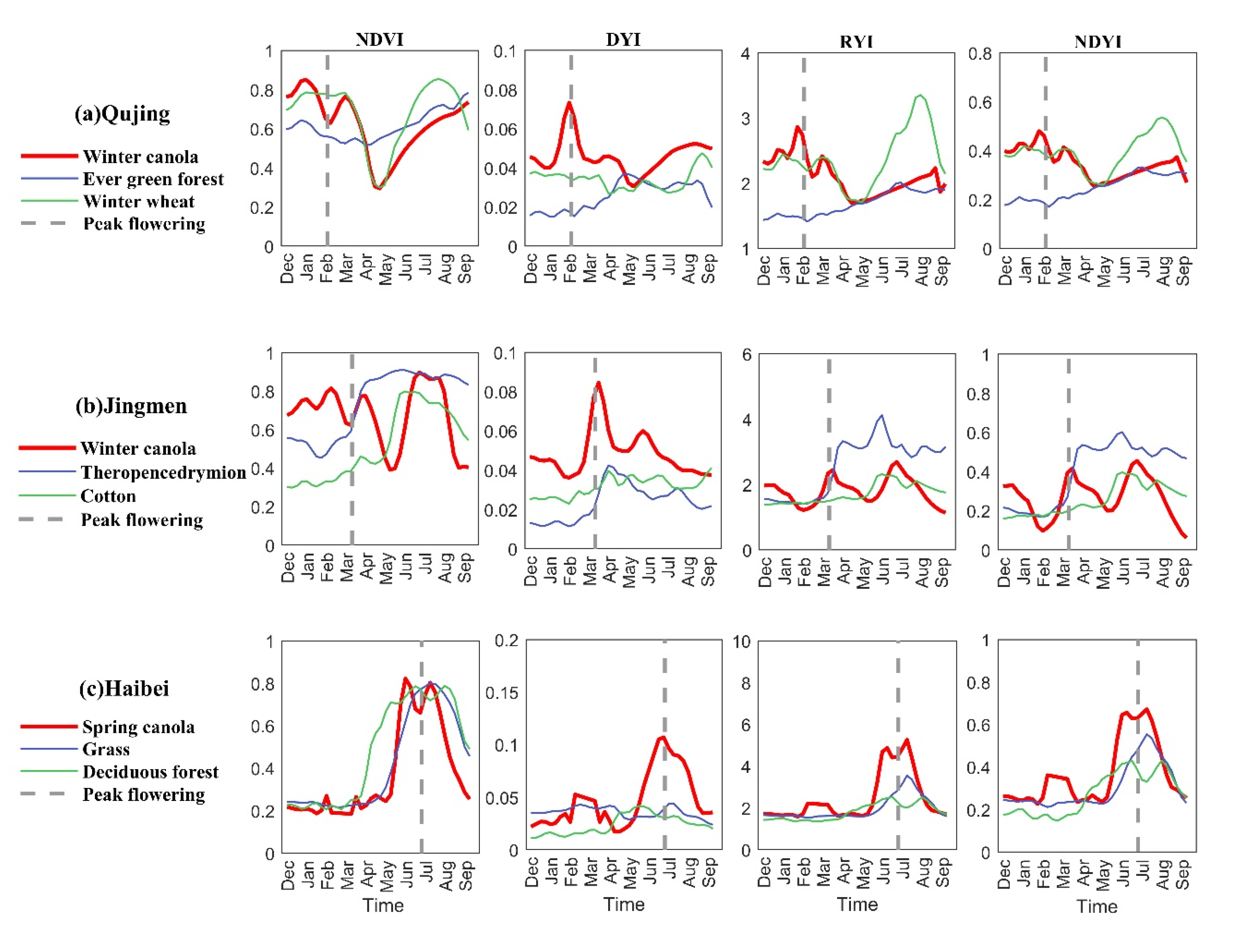
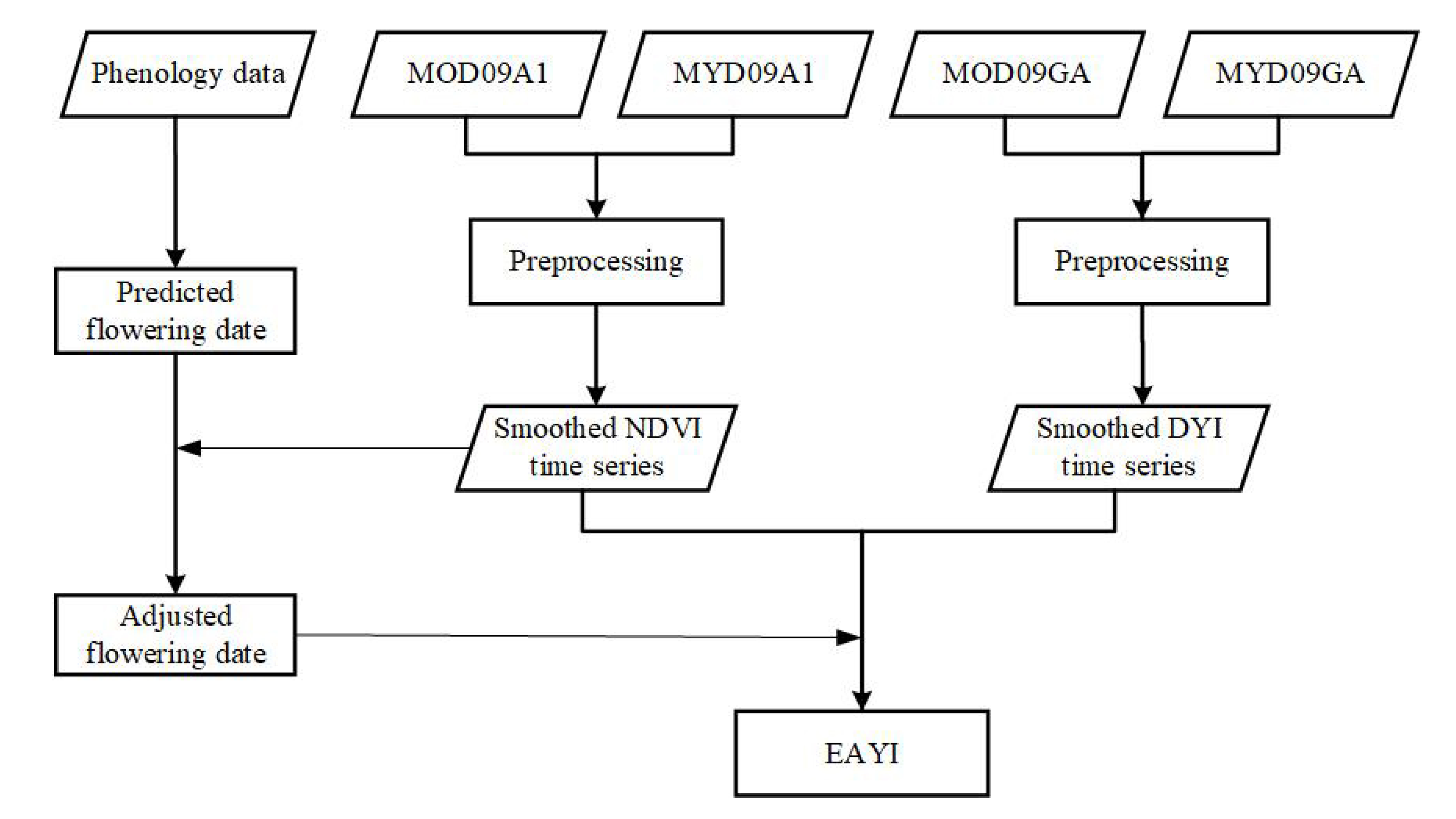
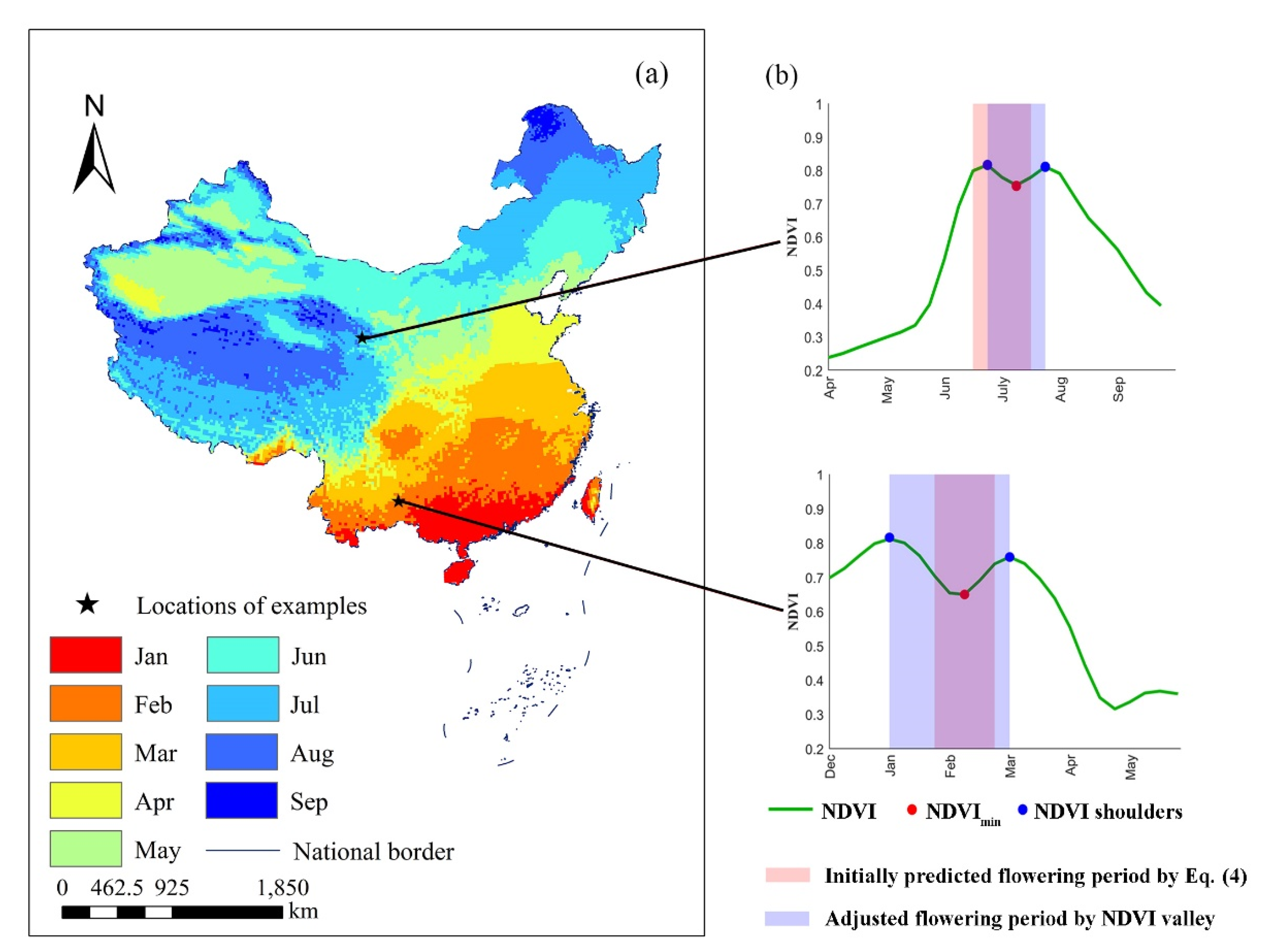
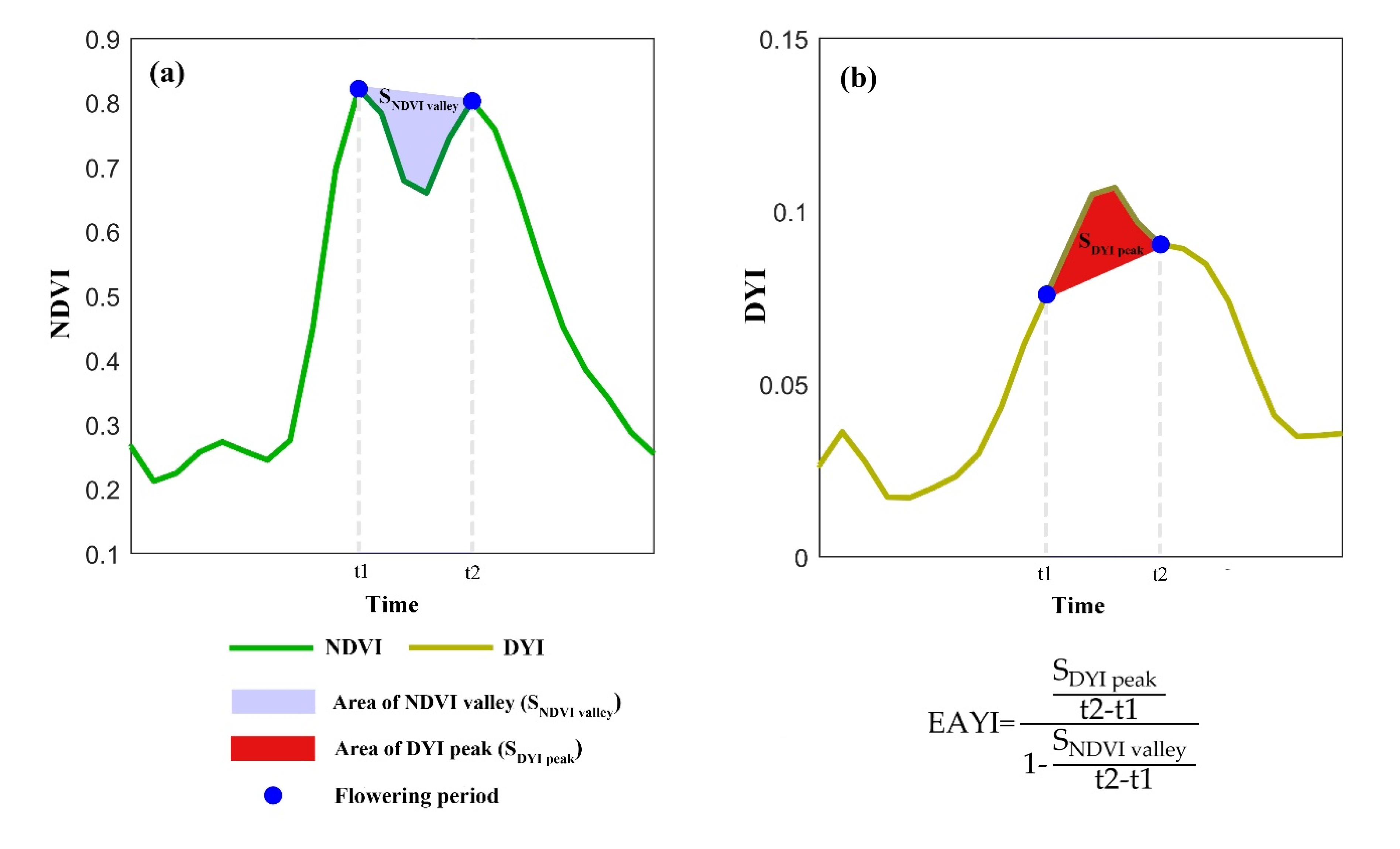

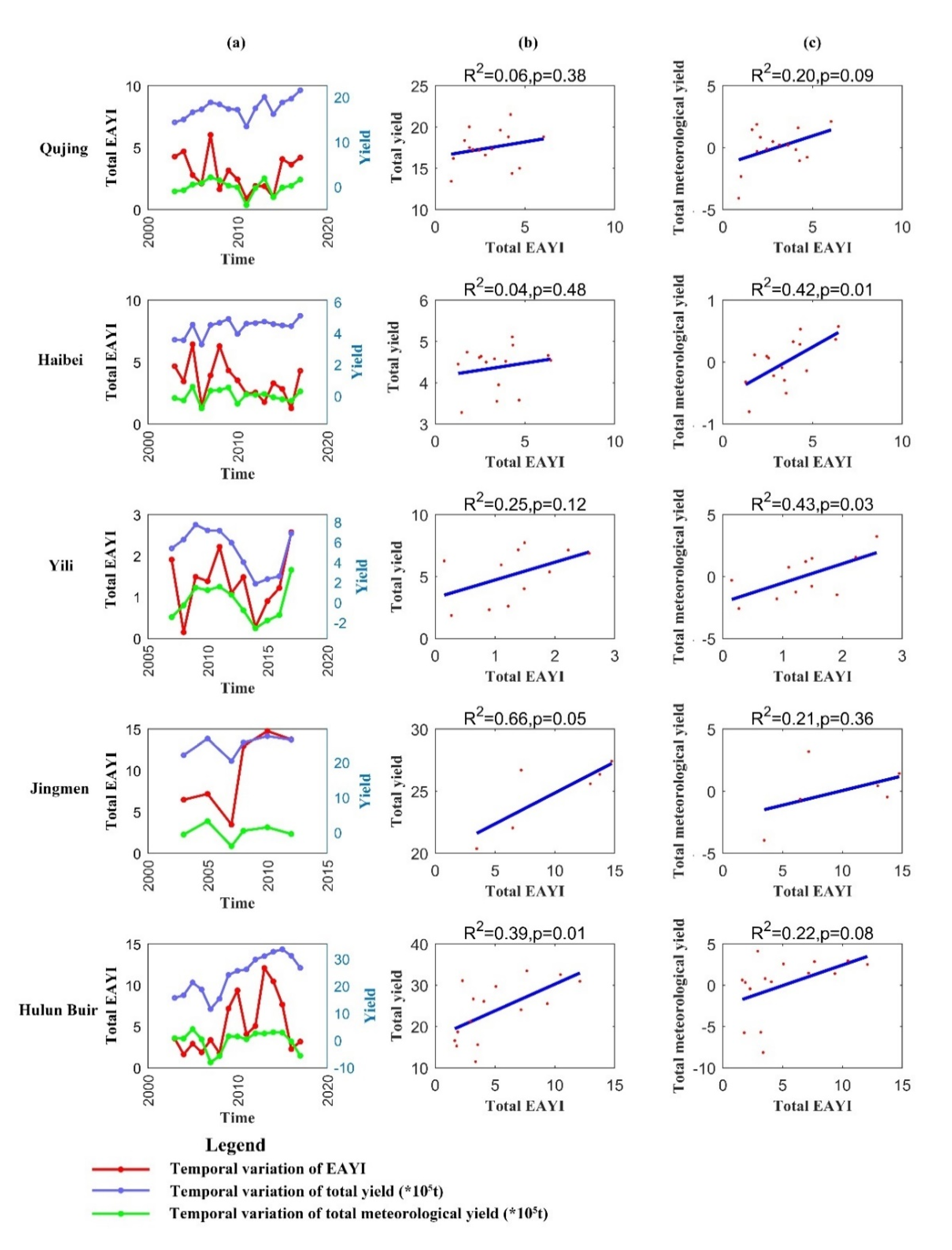


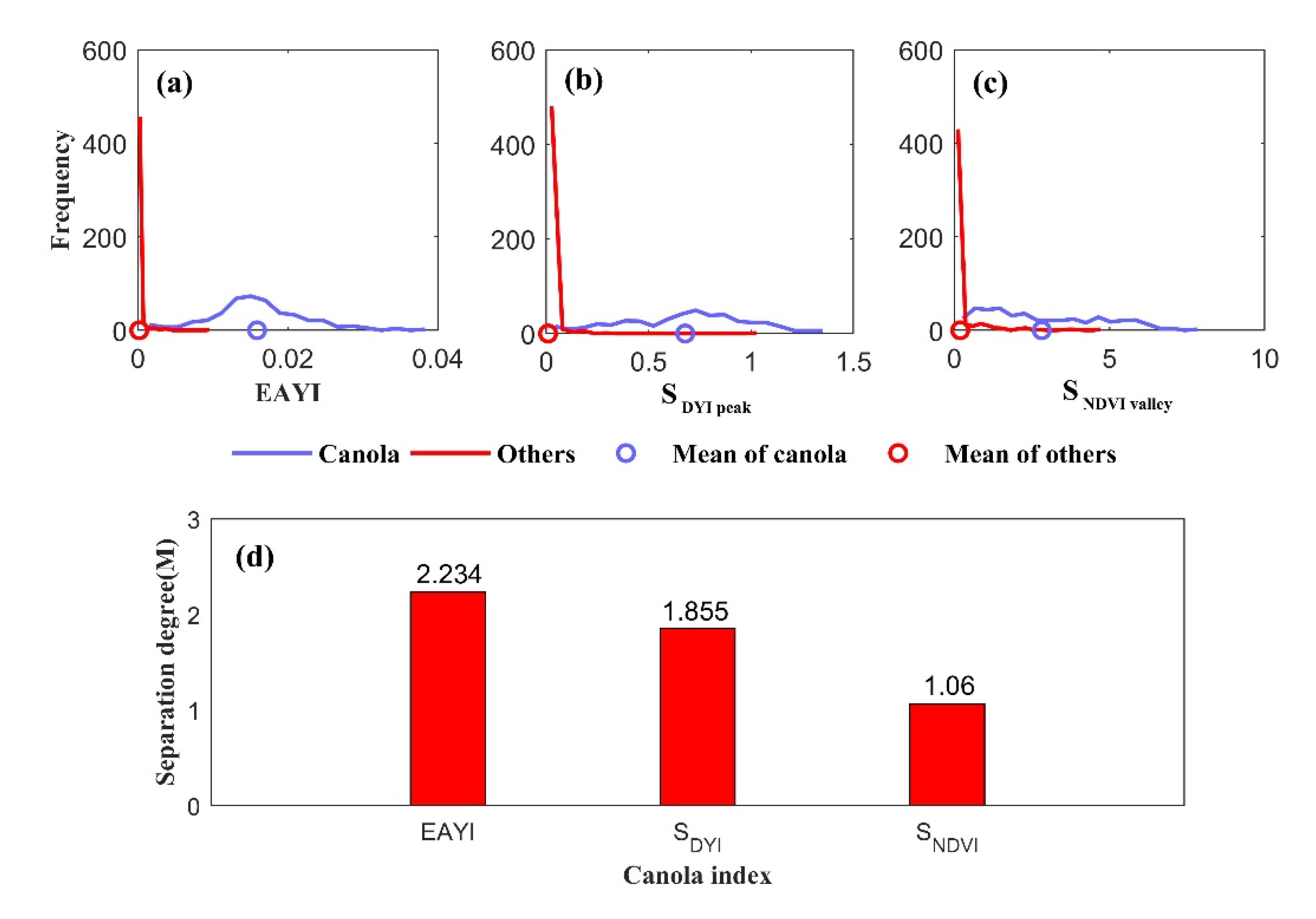

Publisher’s Note: MDPI stays neutral with regard to jurisdictional claims in published maps and institutional affiliations. |
© 2020 by the authors. Licensee MDPI, Basel, Switzerland. This article is an open access article distributed under the terms and conditions of the Creative Commons Attribution (CC BY) license (http://creativecommons.org/licenses/by/4.0/).
Share and Cite
Zang, Y.; Chen, X.; Chen, J.; Tian, Y.; Shi, Y.; Cao, X.; Cui, X. Remote Sensing Index for Mapping Canola Flowers Using MODIS Data. Remote Sens. 2020, 12, 3912. https://doi.org/10.3390/rs12233912
Zang Y, Chen X, Chen J, Tian Y, Shi Y, Cao X, Cui X. Remote Sensing Index for Mapping Canola Flowers Using MODIS Data. Remote Sensing. 2020; 12(23):3912. https://doi.org/10.3390/rs12233912
Chicago/Turabian StyleZang, Yunze, Xuehong Chen, Jin Chen, Yugang Tian, Yusheng Shi, Xin Cao, and Xihong Cui. 2020. "Remote Sensing Index for Mapping Canola Flowers Using MODIS Data" Remote Sensing 12, no. 23: 3912. https://doi.org/10.3390/rs12233912
APA StyleZang, Y., Chen, X., Chen, J., Tian, Y., Shi, Y., Cao, X., & Cui, X. (2020). Remote Sensing Index for Mapping Canola Flowers Using MODIS Data. Remote Sensing, 12(23), 3912. https://doi.org/10.3390/rs12233912






